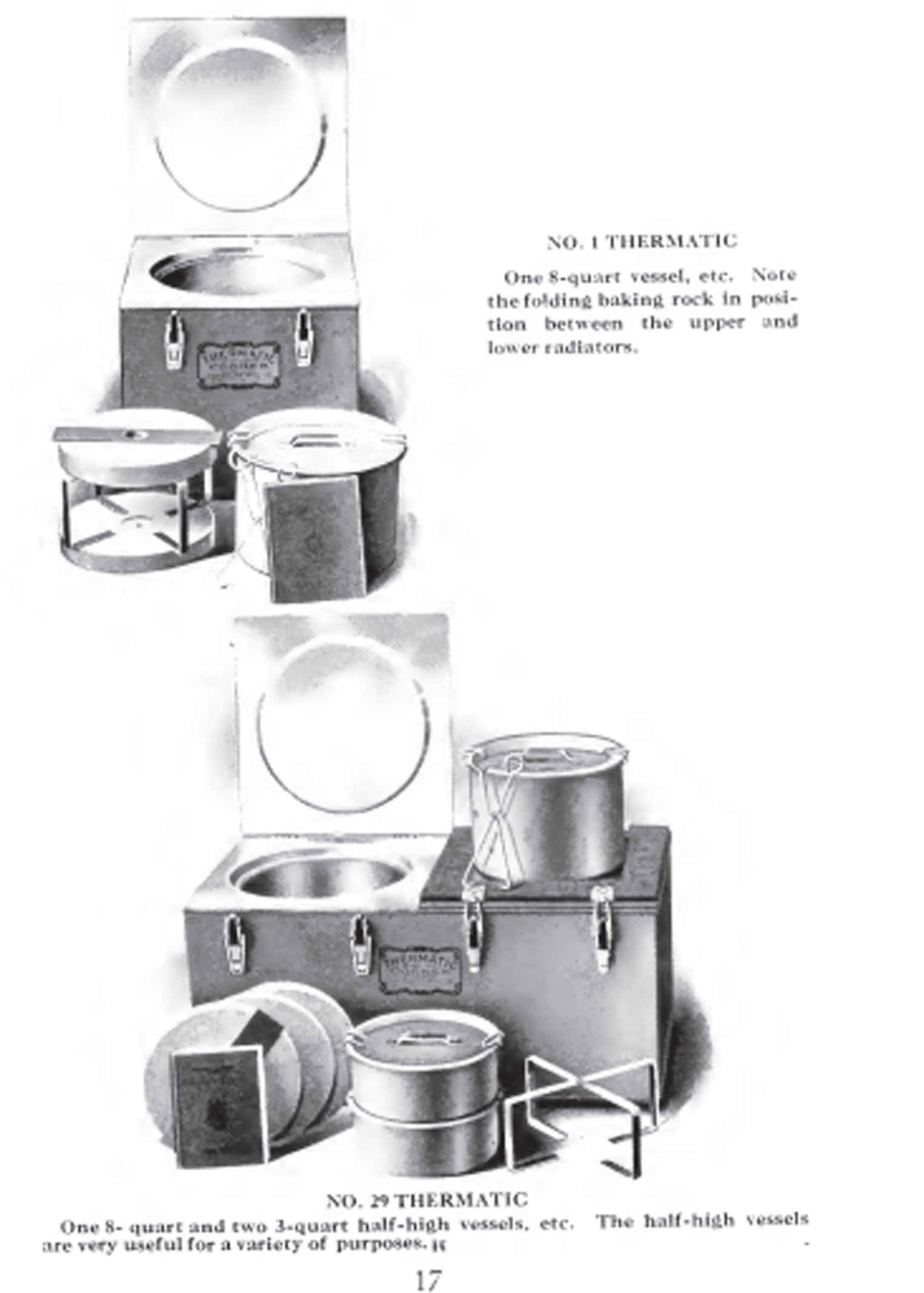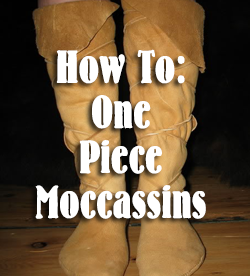The Fireless Cooker
How To Make It, How To Use It,
What To Cook
By Caroline Barnes Lovewell, Frances Dean Whittemore, Hannah Wright Lyon © 1908
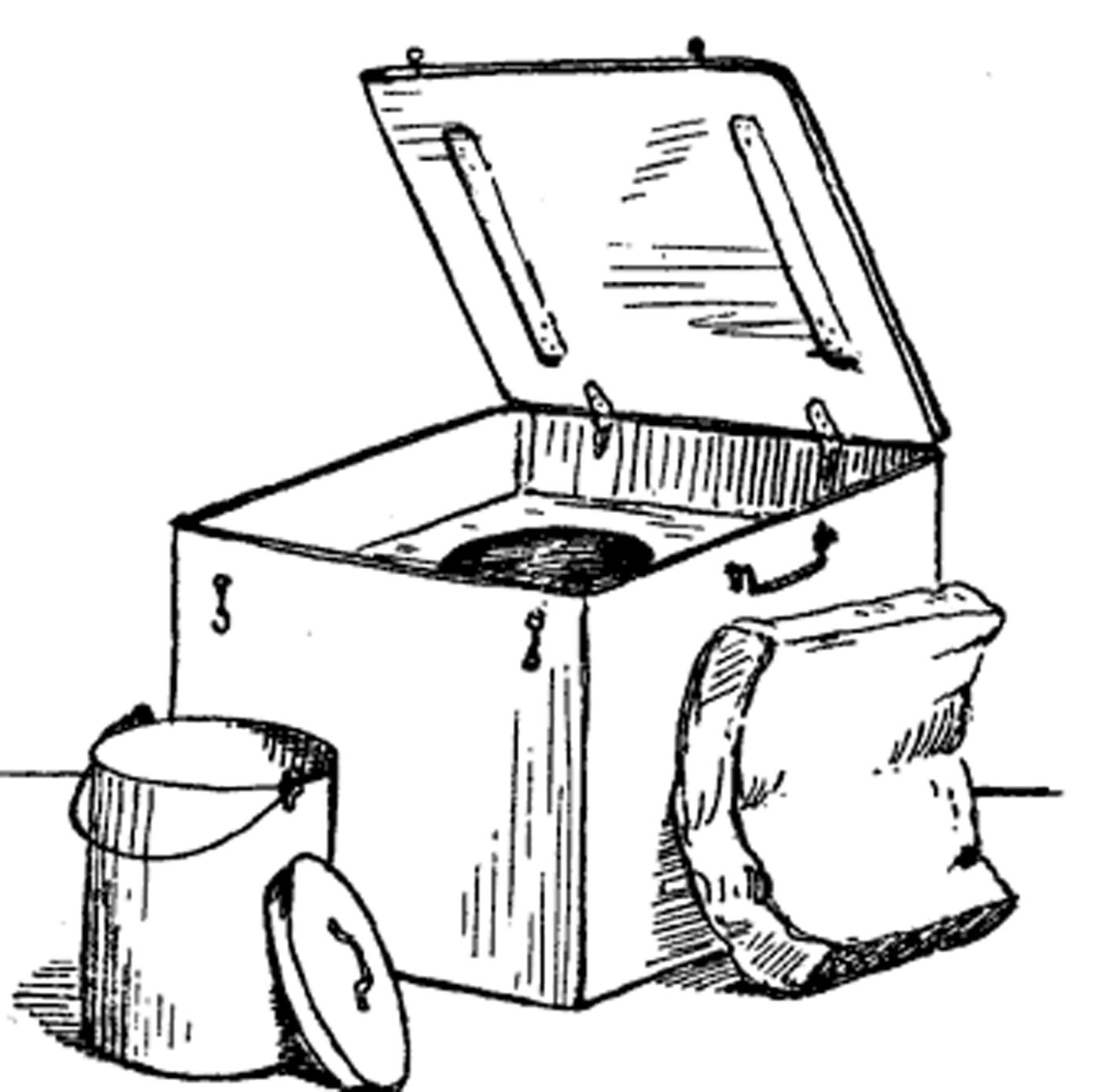
A fireless cooker consists of a kettle or other vessel that can be heated, enclosed in a box or other outer shape, with enough insulating material between them to prevent the heat in the kettle from escaping. Food brought to a boiling point over a fire and enclosed in such a way must continue to cook. It is an easy matter to make such a contrivance. After choosing a good kettle with a tight cover, select a box large enough to allow six or eight inches of insulating material. This must be so adjusted as to form a compartment for the kettle in the middle of the box. Make a firm cylindrical shape to fit loosely around the kettle, and fasten a circular bottom to it. For the packing use wool, cotton, ground cork, crumpled newspaper, or some other non- conductor of heat. Fill the bottom of the box to a depth of three inches, and place the metal or pasteboard cylinder upon it. Pack all around the cylinder up even with the top. Press the packing down very hard. The top of the insulating material may be neatly covered with cloth or metal or with a board having a round hole in it. A thick cushion is now needed to insulate the space above the kettle and the lid of the box should be held closely down. This simple compartment with its single kettle will prove that a fireless cooker is a most useful article in any home. Another compartment with another kettle in it is easily added; then two kettles in each compartment, one above the other.
The ease with which a fireless cooker can be constructed, the small outlay necessary to insure a perfectly efficient and reliable cooker, and the great comfort, convenience, and saving the cooker has been to us, the past two years, have led us to place this wonderful and practical plan of cooking before you. The directions and explanations are the outgrowth of tests and experiments, and this volume is put forth in the hope of helping others. We hope that the conservative or skeptical may be induced to make a cooker, even if ever so simple, and by experimenting realize the good of which it is capable.
The primary object is to save the time and strength of the cook. Women may be so busy in the doing, in the laborious service of the Biblical Martha, that they find no time to accept the invitation, "Come ye apart and rest awhile," whereby to gain steadiness of purpose and power to meet the exigencies which must arise in all daily life.
The fireless cooker saves fuel also, and utilizes many of the cheapest and most nutritious foods. It wins to our glad service the tough but nutritious meats and all kinds of dried beans, peas, lentils, corn, and fruits which we seldom use because of the time and fuel required to make them tender and palatable. The result is that the housewife who is so disposed, may keep a much larger per cent of the family income out of the kitchen and yet "set a good table" of the most deliciously cooked food.
We have adapted our old tried and favorite recipes to the cooker; and many new combinations result from the use of "the articles requiring long cooking. The recipes herein given may supply a family with nutritious and wholesome food, of pleasing variety, and tempting alike to the eye and the palate. Supplement fresh fruits and salad greens, delicate crackers, cheeses, nuts, salad oils, sauces, and candies, according to your taste and pleasure, and the most fastidious are satisfied.
The manager of a cooking box will be willing to study it and its possibilities somewhat as she does a new sewing machine and its attachments. Use a little wise forethought, some careful attention to the menu, and, with recipes skillfully concocted, the result will be a delight. The cooker may not do all the work anymore than the sewing machine does, but it certainly deserves a large place in our culinary department.
Busy women, mothers, teachers, students, and all those who have work outside as well as in the home, may prepare wholesome, nutritious, economical, and attractive dishes, with very little time spent over the kitchen fire.
Many dishes, like the meat and potato stew, vegetable soups, etc., will serve for a complete dinner, with the addition of a dessert of fresh fruits or of a dainty pudding. All of these can be prepared in the cooker early in the morning and be ready for the midday meal or for the dinner at night.
By this method cookery becomes truly laboratory work, and it is probable that fireless cookers of one kind or another will soon be found in nearly every home; on the ranch of the cattle man, in the tenement of the wage-earner, and in the home of the rich. They are already used in Europe. In Sweden they are built into the house adjacent to the kitchen chimney. Hotels in this country are adopting them. The United States army is proving their value at the government posts, and also in the field. Their principal value in the army is as a time saver. Breakfast is prepared during the evening thus avoiding the necessity of the cook's rising before daylight. On the march, after breakfast is served, dinner is prepared, placed in the cookers and on the wagons, and served immediately on arrival in camp, instead of several hours later as has been the custom. The big packing companies appreciate this method and use immense boiling cookers to boil their hams for the market, and claim that they save thereby twenty per cent of shrinkage.
The idea of fireless cooking is still in the process of development, and the most finished cooker of to-day will, no doubt, seem to the future housekeeper as crude and primitive as does the Indian bake oven to us. The cooker need not be of home construction. There are several manufactured cookers on the market. Some of them are of unquestioned merit; and we should be glad, if you wish, to put you in communication with the manufacturers of those which seem to us the most desirable. But we are pledged to no cooker company. Our plea is for the idea, the method, which is so full of promise to the housekeeper. It will save countless steps and much anxiety. It is capable of doing a large part of your cooking while you sleep. And we would like to make the plea so strong that every housekeeper, every mother who gleans hints of helpfulness from this little book, may be induced to adopt the method in her home. What we plead for is a clear recognition of the principle that viands heated to a cooking temperature will continue to cook if surrounded by nonconducting material. Our refrigerators keep the heat from going in, while our cookers keep the heat from going out.
A few blank pages are introduced so that each housewife may adapt and insert her own favorite rules.
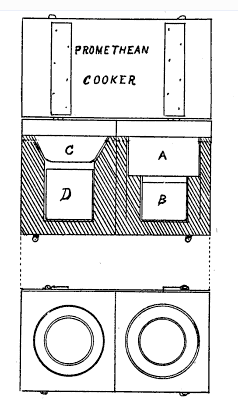
The Promethean Cooker
During the two years and more in which we have experimented with the Fireless Cooker we have tried many models and devices. We have cooked in boxes of various sizes and shapes, in trunks, in a tin bread box, a wooden bucket, and in a barrel; and we have not slighted the pantry drawer nor forgotten the ice box. In all these experiments we have had a good degree of success and the food has really cooked. While we confess that we have a choice as to material, size, and proportion, we have reached the conclusion that any receptacle that can be tightly closed, and in which packing can be placed, may be made to serve as a cooker.
These tests have clearly demonstrated the principle upon which the tireless cooker is based; that of the conservation of heat. When food is heated to the boiling point and kept at that temperature or a little below for a certain length of time by placing it under conditions where the heat cannot escape, the food is bound to cook. It could not do otherwise.
There is a great variety of plans and models with which we are familiar. Many have decided merit and accomplish the object for which they were constructed, but we have found that the cooker illustrated on the opposite page, because of its compact form, its large capacity, and the varied sizes of the utensils used, makes a most desirable and complete cooker for the use of the average family.
Compartment A—B may be lined by joining to the top opening a piece of the' material thirty-seven inches long, the width being equal to the depth of the entire cylinder plus three inches. This is to be laid in small plaits as it is joined to the circular bottom. This will not make so smooth a cover but may seem more simple.
We shall now want some cushions. These must be of varied sizes to meet the different needs. First two cushions are made by cutting for each two pieces of the lining material fifteen inches long and fourteen inches wide and joining them with a strip of the same cloth three inches wide. Fill them evenly and firmly with the packing material. Cotton is especially good for this purpose. They should just fill the space above the cylinders. By sewing together the two round pieces cut from the top lining and filling lightly with cotton a very useful little cushion may be made to place between the dishes. Then there should be a medium sized cushion about twelve inches square filled with cotton or any material that will bear crushing. This may be used when only the lower compartments are in use, pushing it well down over the kettle and placing the square one over it. Experience will teach the best use to be made of the cushions.
To make the linings removable, cover the board tops of the compartments permanently with the lining material, with the edges glued to the underside. Then hem the upper edges of the cylinder linings and fasten them to the tops with some of the snap fasteners found at the dry goods stores. They may then be removed and cleansed as often as you choose.
The special advantage of the little pocket B is that small quantities of food may be put into the kettle, heated to boiling and placed directly in the cooker, without first inclosing in a larger vessel, thus saving the time and fuel consumed in heating a large body of water.
The utensils used with the cooker are a Berlin kettle holding about seven quarts, measuring six inches in depth and ten and one-half inches in diameter; a bucket or kettle seven and one-half inches deep and nine inches in diameter, holding eight quarts; a smaller bucket of three and one-half quarts; and a shallow kettle or baking pan of two and one-half quarts capacity. These are all of granite ware with tight fitting lids.
If the wood of the box is even in color, and of good grain, it may be finished with any of the handsome wood stains that are so much used, or it may be painted as your taste may suggest. In any case you have a tireless cooker that would be an attractive addition to the furnishing of any kitchen and that will pay you many times over for the time and small amount of money involved in the making. If the description, in the reading, seems elaborate or complicated, be assured it will be a simple matter to work it out.
One need not be confined to the size and capacity of the cooker here described or to the material used in its construction. Very handsome boxes may be made especially for the purpose and finished in as ornamental a manner as one chooses. The description is given merely as a suggestive plan that may be easily and inexpensively carried out, and because the cooker described has been such a capable and efficient helper in our kitchen during the many months in which it has been used. It has never disappointed us nor refused to do our bidding.
We have called this box the "Promethean Cooker" since the meaning of the word, "forethought," so well expresses one of the chief merits of this method of cooking.
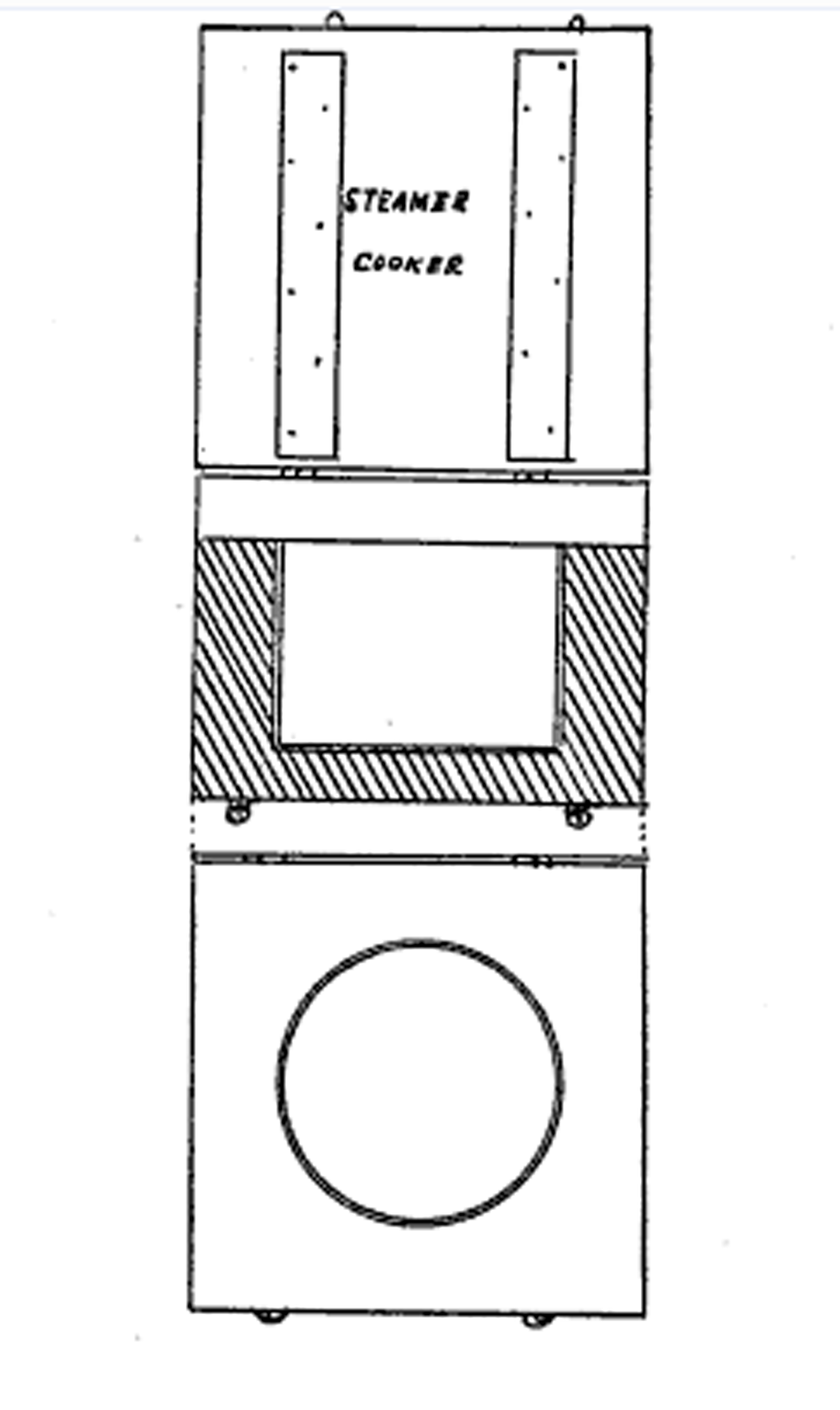
As a supplement to the "Promethean Cooker", for cooking larger quantities of food and for making experiments we constructed our "Steamer Cooker" with a single large compartment. The Steamer Cooker is so called because of the successful steaming which has been possible by its use. This does not mean boiling. A deep wire basket is placed in the boiler as illustrated and the dish containing the pudding, or whatever is to be steamed, is placed in the rack, which holds it well out of the water. The large amount of water supplies a large quantity of heat which cooks the food to perfection, and as quickly a when it is steamed over the fire.
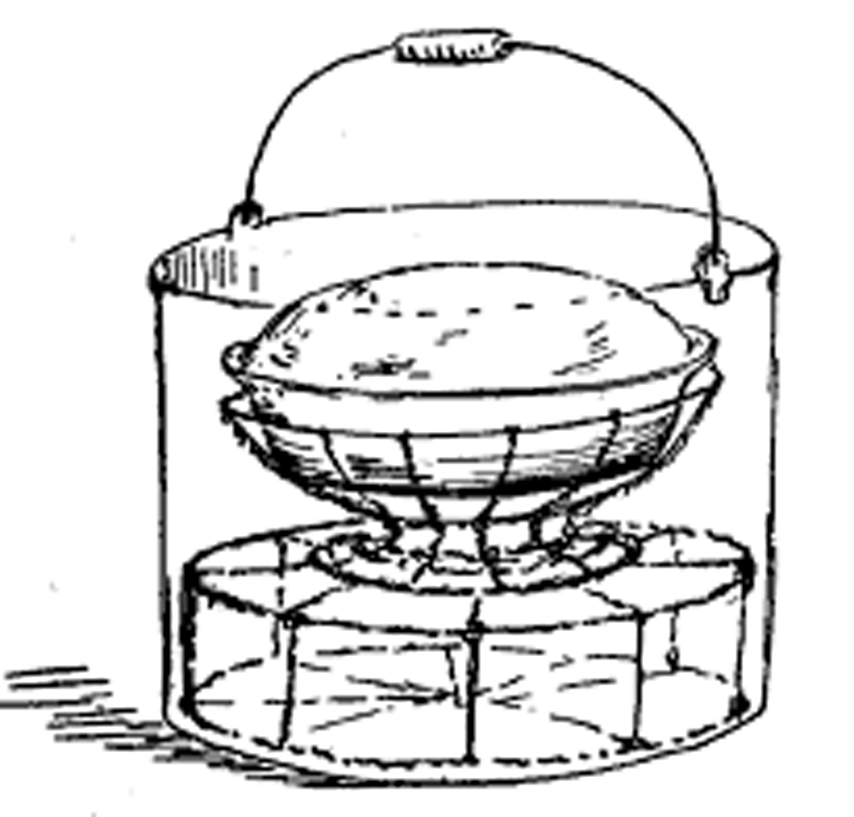
This plan may be carried out successfully in the large kettle of the "Promethean Cooker". Those who have had the kettles over which food was steaming "go dry" and consequently the cooking retarded will appreciate this method of steaming. As there is no evaporation, all the steam generated must remain until the box is opened, and the food is sure to cook.
The box of the "Steamer Cooker" measures eighteen inches in length and width and is fourteen inches high. In this cooker we use a copper boiler with a strong bail and tight fitting cover which we had made for the purpose. This boiler is twelve inches in diameter, eight and one-fourth inches high, and holds three gallons. The box is made and packed in a similar manner to the Promethean Cooker. Such a cooking box would be found most useful in any family of medium size and may be very simply and inexpensively constructed. A large granite kettle may be obtained suitable for the purpose, in place of the copper boiler and will be cheaper. In it may be prepared the Saturday night's supper of Boston baked beans and brown bread and at the same time a dainty dessert.
These dishes may be made ready early in the morning, requiring but a short time over the fire, then shut up in the box and rolled under the table, needing no further care. When the Saturday's work is done, the clean, cool kitchen may be closed, and without a suggestion of heat or steam, or a thought of a fire to watch, a supper to delight the heart of any housewife will be ready at the appointed time, attractive and appetizing. This is possible in the hottest day of summer. Many uses for such a box may be found in every family, the boiling of a ham or chicken, and the cooking of a holiday dinner being among them.
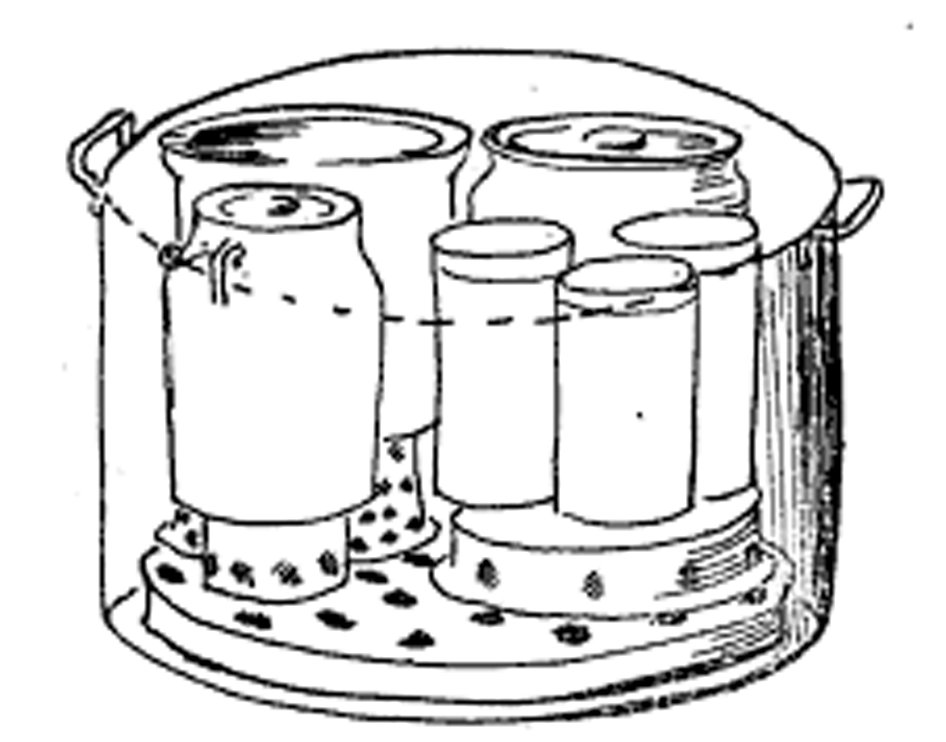
We have a still larger boiler of granite ware holding four and one-half gallons and enclosed in a box of suitable size with three and one-half inches of packing around it. The diameter of this boiler is fourteen inches and the height eight and one-half inches. We have found this very useful for special purposes. In it one may cook enough delicious Boston brown bread for a whole church supper or picnic, if the batter is placed in deep twenty-five ounce baking powder cans. The greater part of a dinner for harvest hands may be put into the boiler early in the morning while it is cool, thus relieving the labor of the housewife. It may cook a ham in one night and the next may boil eight or ten pounds of beef and so solve the problem of meat for many men and for many a day.
The large boilers should be broad rather than deep so that several jars or cans may be placed side by side. These receptacles should reach nearly to the top of the boiler thus allowing a large body of hot water and insuring perfect cooking.
The ingenious woman can adapt the utensils in her pantry to the new uses required by this method of cookery. Porcelain, granite-ware, aluminum, crockery, and stone-ware are all excellent. Tin rusts and should be avoided in steaming. However, tin pans or lids already on hand may be safely used if coated with clear drippings or cottolene and baked. This will darken the tin but not injure it and will prolong its usefulness.
The most serious problem is to secure tight, non-rusting lids. Aluminum covers are already to be obtained in the large cities. Granite jelly pans and pie pans make excellent covers, because they do not rust, and have no hole in the center. Every hole invites defeat. But the ideal cover fits down in an inch or more, or over on the outside as much, and must not be of tin.
Stone jars are quite perfect because they hold heat so well. With care they may be used instead of kettles over a flame.
It is a good plan to have three or four pans, varying in depth, which fit into and upon the big steaming kettles. These pans may hold vegetables, fruits, escalloped foods and puddings, double boiler fashion, with a hot pan or the hot lid of the kettle for a cover; and if the food is to brown, a hot soapstone griddle should be placed above it.
Casseroles and other tasteful forms of baking dishes, and brown ware for steaming and baking puddings and escalloped foods, suitable to be placed on the dining table, may be used since they are not in danger of cracking from too intense heat. A saving in the number of dishes used may thus be effected.
A sheet iron or granite roaster with its own cover is invaluable for roasting in the insulated oven. Heat it and its contents and cover while it is over the flame, and then lock it in the oven with some hot soapstones or fire brick.
Have several wire tea stands, baskets of different sizes, some wire toasting frames, and perforated pans to protect the delicate ware from direct contact with very hot soapstone. These are also useful to support closed dishes in the big steaming kettles permitting the use of more water. A wire basket inverted over food will support a soapstone griddle very close to the food to make a brown crust. A meringue is quickly browned in this way on a table, without heating the oven at all.
For the large boilers and for all the kettles used to enclose smaller vessels there should be a rack of some sort to allow a free circulation of water underneath the dishes containing the food. The rack may be of wire; several tea stands may be placed side by side in a wide kettle; perforated tin or even wood may be used. We had a rack made of the cover of a lard can perforated with three-quarter inch holes. You will be able to work out these details as the need arises.
While the Fireless Cooker does many wonderful and unexpected things, it will not generate its own heat. That must be supplied in abundance from other sources. When steaming or boiling it is essential to have your cooker kettle and its contents very hot. Put it into the box as quickly as possible. Close the box immediately and do not open it again until the food has had time to cook. If for any reason you must open the box before the food is cooked, the kettle must be reheated or the cooking will not be done.
Time tables for cooking with the fireless cooker serve as an approximate guide only, for the time must depend upon both the cooker and the food. Meats may be tough or tender; fowls old or young; vegetables old and pithy, or fresh and succulent; fruits may be sweet or sour; and. all these qualities affect the readiness with which they yield to the influence of heat. The variations are as great as when cooking on coal ranges. Then there is a difference in cookers. Some of them are so well packed as to conserve the heat better than others. The covers of kettles vary. If a kettle of water is scalding hot after standing in the cooker twelve or fifteen hours, you may have faith in your equipment. Generally speaking, the box will require twice or three times as long as a gas or coal range. But, undoubtedly, the longer cooking at the lower temperature is a gain in producing digestible food and in preserving its flavor.
Do not expect a very small quantity of water or food to keep hot ten hours. If you want to cook a small amount for a long time, put it into a small jar or can or pail, and set this into your large kettle of hot water. It will keep hot much longer. The larger the body of heat the longer it will stay hot. Press the cover down tight as you lift the kettle into the cooker. You can hear the boiling at the last instant as you close the lid.
When the homemade cooker is well constructed and packed and properly used, it is entirely efficient and sanitary. As the cooking vessels do not come in contact with the packing material, being effectively separated from it by the board cylinders, and are tightly closed with well fitting lids, the absorption of odors or grease by the packing and cushions is impossible. We find that the cooker made and planned for our own special needs is most satisfactory and often more effective and useful than some of the manufactured articles.
Do not wait to prepare an elaborate box. Select any box that you may find convenient and make a temporary cooker, following the directions given, and fitting it to any kettles that you may have. Be sure to pack the filling down hard and to cover closely when you put the food into the box. The experiment will be an interesting one and you will have the benefit of the plan at once. Then make the more complete and finished cooker as you find it convenient to do so.
When water is brought to the boiling point (212 degrees), additional fuel is used, not to increase the heat, but to keep the water boiling. When a high temperature can be maintained by other means, the time and attention of the cook is saved, as well as fuel, and there is no need to discuss the wisdom of a cooking box.
This magical box, unlike Pandora's, will solve the problem of domestic service in many homes. Trained servants will hail it with joy, and seeing its benefits, will reap the blessings; while untrained help can be taught to accomplish good results with few failures. It would help any maid to have a breakfast box packed with three compartments; one for a coffee pot, one for an oatmeal kettle, and one for a kettle of water fitted under a skillet for ham, breakfast bacon, or hash.
The cooker is a boon to a woman with guests, and especially to the hostess who "does her own work," or has incompetent help. It is invaluable to people who do light housekeeping and it will make housekeeping light to those who acquire the cooker habit. Women need no longer suffer from headaches and nervous exhaustion due to standing over heated stoves.
Water may be heated in the evening and be kept hot for the early morning riser. Hot water or ice may be enclosed in these boxes and will prove a blessing in the sick room. Baby's milk may be kept warm at night.
Yeast bread may be set in the cooker to rise over night. A uniform temperature is thereby assured.
With a two or three burner gas flat, an insulated oven and a good fireless cooker, the meals for a large family may be prepared and the black, unsightly, and expensive range may be dismissed from the kitchen.
This box is as useful in the winter as in the summer. It saves the time of the housewife on short days with their precious hours; for we use more of the foods requiring long cooking in winter than in summer.
Did you ever have the rice or tapioca or macaroni that you were preparing for dinner, rise up and refuse to stay in the kettle? And if, by constant watching, you succeeded in keeping it in subjection, did it not take revenge by sticking to the pot? It is well known to the experienced cook that all foods containing a large percentage of starch have a seeming ambition to rise in the cooking and must be carefully watched that they may not boil over. Although as a rule these articles do not require long cooking, wouldn't it be a relief to place them over the fire only long enough to bring them to the boiling point, and then shut them up in a box where they will not need watching but will continue to cook?
While reapers, listers, gangplows, potato diggers, separators, and countless other mechanical devices have mitigated the drudgery of farm labor, the question of feeding the laborer must be answered, and here the burden falls upon the housewife, and machinery has not as yet brought much respite to her never ending toil. We believe that the fireless cooker will be a boon to these toilers, in giving hours of rest and respite when preparing the regular meals for the "men folks." It saves much anxiety in watching the cooking of food. At the same time the meals will be better served and always on time. Hot appetizing lunches may be served in the field and in many cases long journeys can be saved for the men, who will thus accomplish more work.
Planning for these things will be in itself an education and will raise kitchen work to the plane of skilled labor. It is not so much the work which crushes life out of our women as the monotony of tasks that never end and that never stimulate thought. There must be periods of rest, such as the fireless cooker will bring when doing its work, when the mistress can rest her weary hands and at the proper time be fresh to complete the preparation for the coming meal.
In your initial experiments in this method of cooking remember hot food, tight lids, and tight coverings as the most essential points. Then don't distrub the food until the given time. Remember that half-heated and carelessly packed kettles and pails will result in failure of some sort. Give the plan a good honest chance to win and it will do so every time.
Considerable self-control may be required during your first experiment to resist the temptation to open the cooker and lift the lids "just to see if it is cooking." But this, like all temptations, should be firmly put aside. However, if the temptation proves too strong and a peep is not to be resisted, the kettle must be returned to the fire and brought again to the boiling point, then placed in the cooker, tightly covered, to remain its allotted time.
The use of a cooking box on Sunday makes possible a day of genuine rest. A good dinner left in the box will be found ready for the table on returning from church, with the desirable flavors all retained and no steaming odors permeating the parlor nor even the pantry. Even the water used in steaming is ready for the dish washing.
An overheated or disorderly kitchen full of steam, smoke, and vegetable odors, may be transformed into a room perpetually attractive and neat.
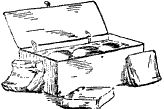
Your grocer will smile when you tell him your plan for his discarded candy pail. But you can accept his implied skepticism with equanimity, knowing that "he laughs best who laughs last." This pail may be lined in such a way as to have a deep roomy compartment for a number of vessels. It may one day carry coffee, beans, escalloped dishes and other hot foods to church suppers or to skating or boating parties. Another day it will keep cold things cold for you, and carry butter, ice cream, salads, fruits, and sandwiches on automobile trips, or to picnics and other outings.
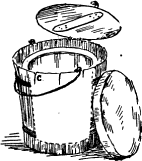
Suggestion for cooking a dinner in one kettle all at one time: Roast beef in jar resting upon a wire frame, and should reach two-thirds the height of the meat jar. Then cook all over the flame a few minutes before consigning them to the box. This combination may safely remain in the cooker from four to six hours. In any case the potatoes should be dried over a flame before serving.
Another plan: Let the jar contain a pudding and be surrounded by beets, or turnips or cabbage. Place escalloped potatoes in the deep pan, and lamb or pork chops in the shallow pan. This combination may safely remain in the cooker eight or ten hours.
Soups have much to recommend them. While their nutritive value is high, they may be made of the cheapest materials. The skill of the cook is shown in the flavors secured by the appetizing combinations of seasoning. Now that we have cooking boxes to help in the long time which is necessary for preparing them, soups may well have a much more important place in the menu than we have heretofore given them. A fine soup aids in digestion and adds to the general sum of happiness.
Soups may be prepared, seasoned, and made ready for the table, and placed in the cooker several hours before they are needed. The fire is then free for the preparation of the remainder of the dinner. The soup will require no further care, and there will be no boiling away, the flavor will be improved, and it will be found sufficiently hot for the table.
Brown Soup StockTake six pounds of the shin of beef, the middle of the round, or the neck. Cut the lean meat into inch pieces and have the bones well cracked. Put the fat and if needed a little butter into a frying-pan with a medium sized onion. When browned take them out and put them into the cooker kettle. To the remaining fat add half the meat and when it is well browned, put it into the kettle. Pour a little hot water into the frying pan and then into the kettle with the remainder of the lean meat, the bones, and any trimmings of veal, poultry or beef, either cooked or raw that you may have. Pour over all about five quarts of cold water. Heat very slowly and skim carefully. When it is clear and boiling consign it to the cooker for ten hours or over night.
In the morning reheat and add one-half cup each of chopped carrot and turnip, ½ (one-half) tablespoonful of peppercorns, 1 (one) tablespoonful of salt, 1 (one) bay leaf, 1/3 (one-third) cup of green celery leaves chopped, and 2 (two) sprigs of parsley. Remove to the cooker when boiling and let remain one hour. Then strain and cool.
